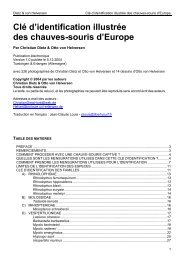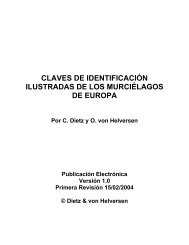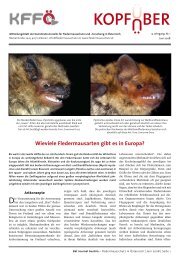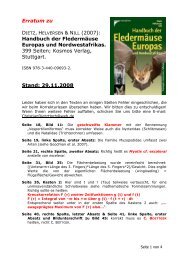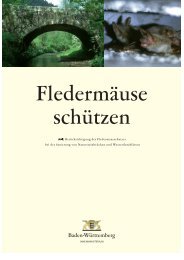Dietz & von Helversen Illustrated Identification key to the bats of ...
Dietz & von Helversen Illustrated Identification key to the bats of ...
Dietz & von Helversen Illustrated Identification key to the bats of ...
You also want an ePaper? Increase the reach of your titles
YUMPU automatically turns print PDFs into web optimized ePapers that Google loves.
<strong>Dietz</strong> & <strong>von</strong> <strong>Helversen</strong><strong>Illustrated</strong> <strong>Identification</strong> <strong>key</strong> <strong>to</strong> <strong>the</strong> <strong>bats</strong> <strong>of</strong> EuropeIV) Genus Pipistrellus (Pipistrellus pipistrellus – Pipistrellus pygmaeus –Pipistrellus kuhlii – Pipistrellus nathusii)Pipistrelles can be quite difficult <strong>to</strong> identify. It is important <strong>to</strong> consider <strong>the</strong> teeth and aset <strong>of</strong> o<strong>the</strong>r characters. However, with some experience most <strong>of</strong> <strong>the</strong> “qualitative”characters can be evaluated on first sight.1) First upper incisor with a single cusp, second upper incisor small (withoutmagnifying lens it appears <strong>to</strong> be only one single cusped <strong>to</strong>oth) (Fig. 179 and 182).The last upper premolar (P 4 ) is in contact with <strong>the</strong> canine (Fig. 179) (no smallpremolar (P 2 ) visible from <strong>the</strong> outside, if present, displaced <strong>to</strong> <strong>the</strong> inside). Usually awell defined white stripe along <strong>the</strong> margin <strong>of</strong> <strong>the</strong> arm wing membrane between fifthfinger and hind foot (Fig. 183), usually also present along tail membrane andbetween fifth and fourth finger. Ears lighter brown, usually not blackish (Fig. 160 and162). Dorsal pelage with dark black bases and sandy yellowish-brown tips (Fig. 160).Some individuals are dark brown without light tips, <strong>the</strong>y resemble in coloration P.nathusii. FA: 30.3 – 37.1 mm, D5: 40 – 45 mm, D3: 54 – 61 mm. – Pipistrellus kuhliiAdditional characters: Posterior margin <strong>of</strong> <strong>the</strong> ear with a sharp indentation (Fig. 162).Penis is spear-shaped and without a medial stripe (Fig. 163) (its colour and shape even injuveniles quite similar <strong>to</strong> Nyctalus leisleri). The white stripe along <strong>the</strong> wing membrane isabout 1 - 2 mm wide but up <strong>to</strong> 5 mm wide in animals from <strong>the</strong> south <strong>of</strong> <strong>the</strong> range.Distribution in Europe: Occurring mainly in sou<strong>the</strong>rn Europe in <strong>the</strong> whole Mediterranean,extending range northwards, reaching recently <strong>the</strong> sou<strong>the</strong>rnmost parts <strong>of</strong> Germany andAustria. Missing or rare in <strong>the</strong> nor<strong>the</strong>rn Balkan countries, absent from Romania, confined<strong>to</strong> <strong>the</strong> south in Bulgaria.Pho<strong>to</strong>graphs: 160 – 163, 175 and 182 – 183. Drawings: 179 (and 174).49



